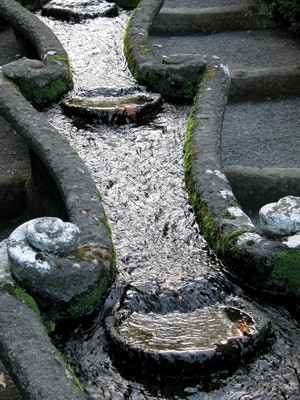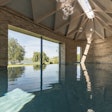



For those who believe that aquatic design began with the swimming pools of the 20th Century, think again, says landscape architect and educator Mark Holden, an artist who has spent a career studying classic works from Rome to the High Renaissance. Here he offers a tantalizing glimpse into the beautiful aquatic antiquities found in the sprawling gardens of Italy's Villa Lante, a virtual laboratory of hydraulic effects that inspire many of today's most visionary designers.
The gardens of Villa Lante are among the most beautifully crafted and preserved of all Renaissance Italy. Known as Villa Lante at Bagnaia, located near Viterbo in central Italy, this monument to Mannerist design is attributed to architect Jacopo Barozzi da Vignola commissioned by Cardinal Gianfrancesco Gambara in the mid 16th Century.
It is widely considered a true masterpiece of Renaissance architectural and garden design, and now stands as one of the most immaculately maintained of all of the great Italian villas and gardens.
As a landscape architect working in the field of aquatic design, I've long been fascinated by the use of water in the great gardens of the world. The fountains, ponds, grottos and waterways of Villa Lante are among the best examples of Italian Renaissance aqua architecture still available to modern designers. This most historic of places is both transcendently beautiful and also enormously useful as a sort of laboratory of masterfully executed hydraulic details.
For my part, one of the most significant benefits of visiting places of this caliber are the ways in which the ideas of past masters can be transplanted into the work we do today. In this case, the ingenious features of Villa Lante are largely credited to 16th Century hydraulics engineer Tommasco Ghinucci, who succeeded in creating a mesmerizing system of interconnected features that unify the gardens in a constant flow of form, texture, motion and axial geometry.
(Interestingly, for centuries the water flowing through Villa Lante's gardens would exit the hillside property and flow into the town below where it served as public utility, yet another aspect of the site's ingenious design.)
Studying this tapestry of aquatic features could take years. For our purposes here, I'd like to focus on two specific elements that are both beautiful and instructive. The first is the site's water chain, one of only two of its kind and vintage operating in all of Italy. Rendered in stone to represent the scalloped shape of Crayfish, this water chain utilizes both precise volume and flow rate to create an almost hypnotic texture in the water's surface. The chain widens and narrows, causing water to slow and then accelerate, further enhancing the sensory experience with a fascinating oscillating effect, all the while generating a beautifully tranquil sound.
The chain terminates in a stunning reflecting pond, part of what's known as the Fountain of the Moors, where Ghinucci switches gears. Here he brings the water to a quiescent halt where it generates dramatic reflections of adjacent statuary and architectural features, a beautiful resting point on the water's journey through the gardens.
In both artistic and practical terms we see how both the surface tension of water and its reflective qualities can be used to enhance the most beautiful and beloved of spaces.











































